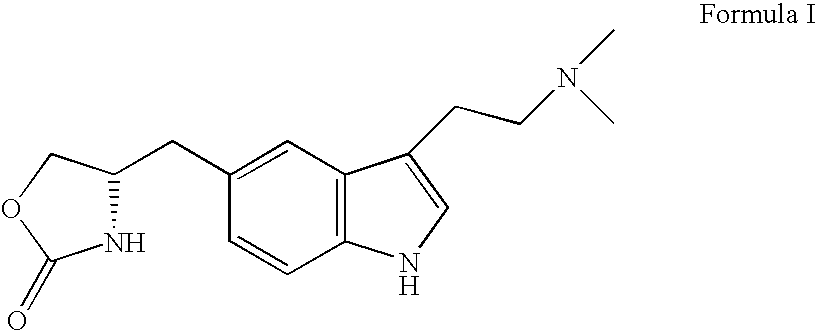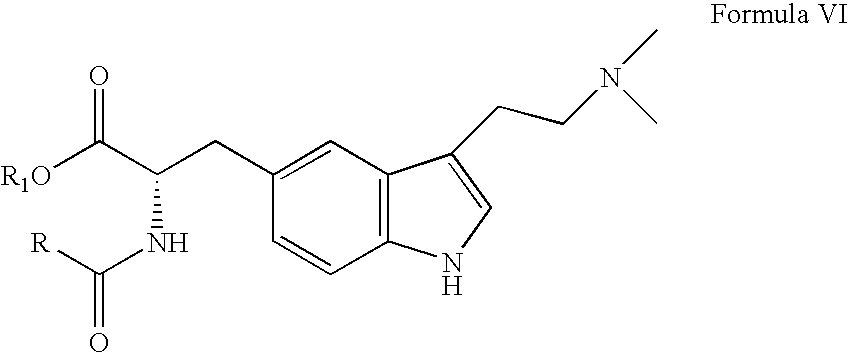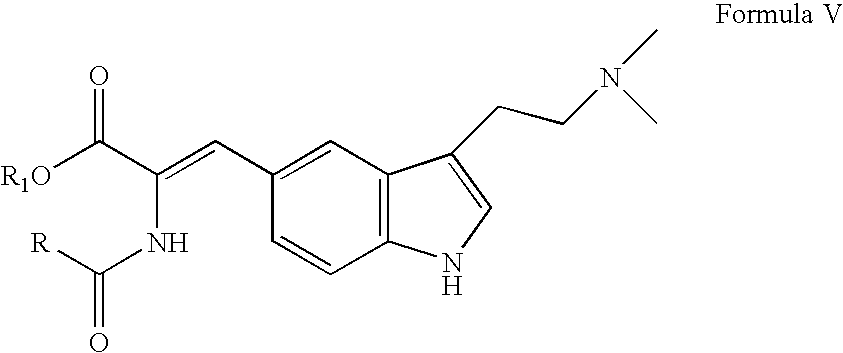Enantioselective process for the preparation of zolmitriptan
a technology of enantioselective process and zolmitriptan, which is applied in the field of enantioselective process for the preparation of zolmitriptan, can solve problems such as undesirable racemerization
- Summary
- Abstract
- Description
- Claims
- Application Information
AI Technical Summary
Benefits of technology
Problems solved by technology
Method used
Image
Examples
example 1
Preparation of 4-bromophenylhydrazine hydrochloride (III)
[0052]
[0053]A suspension of 35.34 g of 4-bromoaniline in 200 mL of water and 400 mL of concentrated hydrochloride was cooled to 0° C. To this suspension was added 14.1 g sodium nitrite in 130 mL of water over 30 min. The temperature was maintained at 0 to 5° C. and stirred for another 30 min after addition. The solution was then added at 0° C. over 30 min to a stirred solution of tin (II) chloride (192 g) in 350 mL of concentrated hydrochloride, followed by 3 hours stirring at room temperature. The system was cooled to 5° C. and the solid was collected by filtration and dried at 40° C. under high vacuum to provide 36 g of the product as a white solid.
1H NMR (DMSO-d6, δ): 6.90 (d, 2H, Ar), 7.44 (d, 2H, Ar), 8.40 (br, 1H), 10.19 (br, 3H).
example 2
Preparation of 2-(5-bromo-1H-indol-3-yl)-N,N-dimethylethanamine (IV)
[0054]
8.3 g of 4-dimethylaminobutanal diethylacetal (Tech grade from Aldrich) was added to a solution of 11.3 g of the product from Example 1 in a mixture of acetic acid (110 mL) and water (5 mL) and the resulting mixture was refluxed for 4 h. The mixture was cooled and evaporated in vacuum. The residue was dissolved in 100 mL of water and the pH was adjusted to 8˜9 by saturated sodium bicarbonate, then extracted with 5×50 mL of dichloromethane. The combined organics were concentrated in vacuo and the residue was eluted through a silica column using DCM / EtOH / NH4OH (30:8:1) as eluant to give 3.0 g of the desired product as a pale yellow oil.
1H NMR (DMSO-d6, δ): 2.53 (s, 6H, NMe2), 2.93 (s, 4H, CH2CH2), 7.16 (d, 1H, Ar), 7.26 (s, 1H, Ar), 7.33 (d, 1H, Ar), 7.75 (s, 1H, Ar), 11.20 (s, 1H, NH).
example 3
Preparation of (Z)-2-(acetylamino)-3-{[3-N,N-(dimethylamine)ethyl]-1H-indol-5-yl}-2-propenoic acid methyl ester (V)
[0055]
[0056]A 100 mL Schleck flask was filled with 2.1 g of the product from Example 2, methyl 2-acetamido acrylate (1.8 g), diisopropylethylamine (4 mL) (o-MePh)3P (940 mg), Pd(OAc)2 (172 mg) and NMP (30 mL). Nitrogen atmosphere was applied, a stirring bar was added and the mixture was heated and stirred at 125° C. for 4 h. The mixture was cooled and solvent was removed under high vacuum as much as possible and poured into 50 mL of water. The mixture was then extracted with 5×50 mL of dichloromethane. The combined organics were concentrated in vacuo and the residue was eluted through a silica column using DCM / EtOH / NH4OH (50:8:1) as eluant to give 700 mg of the desired product as a pale yellow oil.
1H NMR (CD3OD, δ): 2.16 (s, 3H, CH3CO), 2.38 (s, 6H, NMe2), 2.68-2.74 (m, 2H), 2.92-3.00 (m, 2H), 3.81 (s, 3H, OMe), 7.12 (s, 1H), 7.35 (d, 1H), 7.42 (d, 1H), 7.64 (s, 1H), 7....
PUM
 Login to View More
Login to View More Abstract
Description
Claims
Application Information
 Login to View More
Login to View More - R&D
- Intellectual Property
- Life Sciences
- Materials
- Tech Scout
- Unparalleled Data Quality
- Higher Quality Content
- 60% Fewer Hallucinations
Browse by: Latest US Patents, China's latest patents, Technical Efficacy Thesaurus, Application Domain, Technology Topic, Popular Technical Reports.
© 2025 PatSnap. All rights reserved.Legal|Privacy policy|Modern Slavery Act Transparency Statement|Sitemap|About US| Contact US: help@patsnap.com



